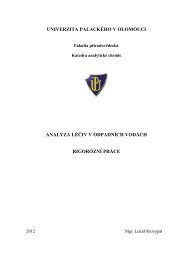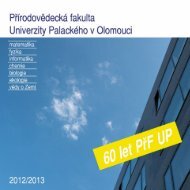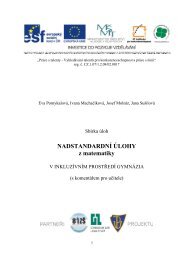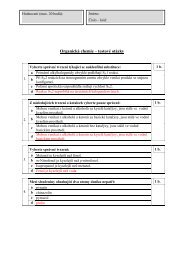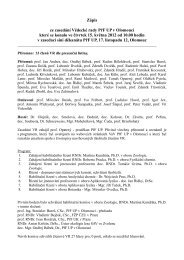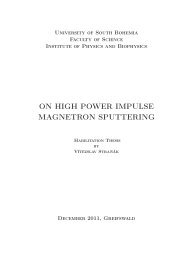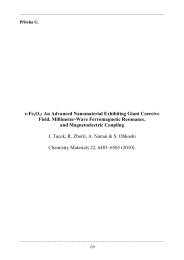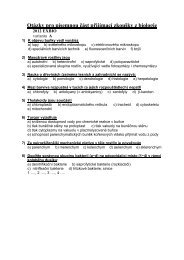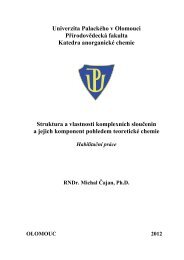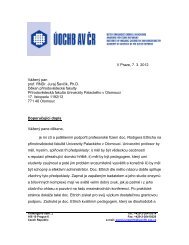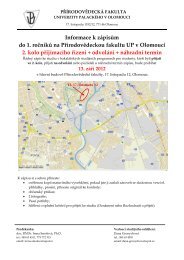A comparative structural analysis of direct and indirect shoot ...
A comparative structural analysis of direct and indirect shoot ...
A comparative structural analysis of direct and indirect shoot ...
Create successful ePaper yourself
Turn your PDF publications into a flip-book with our unique Google optimized e-Paper software.
M. OVECKA & M. BOBf~K<br />
point <strong>of</strong> view redefined plant cell wall (Roberts<br />
1989) appears to be a dynamic <strong>and</strong> active cellular<br />
compartment, mediating cell signalling through the<br />
special wall integral part referred to as an extracellular<br />
matrix (Roberts 1994). It is not surprising that<br />
plant cell <strong>and</strong> tissue surfaces became very attractive<br />
objects in the study <strong>of</strong> cell adhesion <strong>and</strong> separation<br />
during the cell differentiation <strong>and</strong> tissue morpho-<br />
~-enesis (Roberts 1989, 1994, Knox 1992a, b).<br />
In embryogenic culture <strong>of</strong> Papaver somniferum L.<br />
in vitro, we evaluated morphological variability <strong>of</strong><br />
somatic embryos (Ove~ka et al. 1996), <strong>and</strong> the secondary<br />
regeneration ability <strong>of</strong> embryo cells during<br />
subsequent long-term cultivation was described<br />
(Ove~ka et al. 1997/98). The aim <strong>of</strong> this study is the<br />
description <strong>of</strong> the fine structure <strong>of</strong> cell <strong>and</strong> early<br />
embryo surfaces (including cell wall, <strong>and</strong> structures<br />
located extracellularly) during long-term somatic<br />
embryogenesis, compared to the <strong>structural</strong> characteristics<br />
<strong>of</strong> cell <strong>and</strong> tissue surface organisation in<br />
early stages <strong>of</strong> opium poppy <strong>shoot</strong> regeneration in<br />
vitro.<br />
Materials <strong>and</strong> Methods<br />
Somatic embryogenesis <strong>of</strong> Papaver somniferum L.<br />
was initiated <strong>and</strong> maintained as previously described<br />
(Ove~ka et al. 1996). Briefly, embryogenic<br />
callus culture was induced from unripped seeds on<br />
MS induction medium (Murashige <strong>and</strong> Skoog<br />
1962), supplemented with various concentrations<br />
<strong>of</strong> ct-naphtaleneacetic acid <strong>and</strong> kinetin. Somatic<br />
embryos regenerating on hormone-free medium<br />
followed a long-term proliferation with the capacity<br />
<strong>of</strong> secondary somatic embryogenesis.<br />
Long-term organogenic culture <strong>of</strong> Papaver somniferum<br />
L. was induced from unripe seeds on Murashige<br />
<strong>and</strong> Skoogs (1962) medium, supplemented<br />
with c~-naphtaleneacetic acid <strong>and</strong> benzylaminopurine,<br />
or indoleneacetic acid <strong>and</strong> kinetin (Samaj et al.<br />
1990, Ove6ka et al. 1997).<br />
Resin-embedded samples for transmission electron<br />
microscopy (TEM) were fixed in 5 % glutaraldehyde,<br />
buffered with phosphate buffer for 5 h, <strong>and</strong><br />
postfixed in 2 % osmium tetroxide for 2 h, buffered<br />
with the same buffer. After dehydration in acetone,<br />
the samples were embedded in Durcupan ACM<br />
(Fluca). Ultrathin sections stained with uranyl acetate<br />
<strong>and</strong> lead citrate were examined using Tesla BS<br />
500 electron microscope. Semithin resin sections <strong>of</strong><br />
1-1.5 pm thickness prepared for light microscopy<br />
were stained with 1% aqueous toluidine blue <strong>and</strong> 2<br />
% aqueous basic fuchsine. Samples for scanning<br />
electron microscope (SEM) were fixed in 3 % buffered<br />
(phosphate buffer) glutaraldehyde for 48 h <strong>and</strong><br />
2 % buffered osmium tetroxide for 1 h. Samples dehydrated<br />
in ethyl alcohol were critical point dried in<br />
CO2, sputter-coated with gold (20 nm) <strong>and</strong> examined<br />
in scanning electron microscope JXA 840A<br />
(JEOL) at 15 kV. Some critical point dried samples<br />
were immersed in ethyl alcohol, transferred to butyl<br />
alcohol, infiltrated <strong>and</strong> embedded in Histoplast S<br />
(Serva). Sections <strong>of</strong> 8-10 pm thickness were dewaxed<br />
<strong>and</strong> prepared for light microscopy without<br />
additional staining, or stained with the periodic<br />
acid-Shifts reaction (PAS).<br />
Results<br />
Somatic embryogenesis was induced in embryogenic<br />
callus culture by activation <strong>and</strong> determination<br />
<strong>of</strong> competent cells with growth regulators, <strong>and</strong><br />
competent cells expressed their embryogenic potential<br />
on hormone-free medium. Cetlular organisation<br />
<strong>and</strong> cell adhesion were different depending<br />
on particular steps <strong>of</strong> embryonic activation, determination<br />
<strong>and</strong> expression. Population <strong>of</strong> competent<br />
cells were arranged in compact embryogenic clusters,<br />
located predominantly in surface <strong>and</strong> subsurface<br />
cell layers <strong>of</strong> callus. The cells in clusters undergoing<br />
frequent cell divisions maintained<br />
meristemic-like appearance, however r<strong>and</strong>om orientation<br />
<strong>of</strong> cell division plane determined cell rearrangement<br />
within the clumps after cell division<br />
(Fig. 1 a). On the other h<strong>and</strong>, differentiated protodermis<br />
<strong>of</strong> globular, heart-shaped <strong>and</strong> torpedo somatic<br />
embryos comprising files <strong>of</strong> tightly arranged,<br />
convex-shaped cells elongated in the <strong>shoot</strong>-root <strong>direct</strong>ion<br />
was the most remarkable aspect <strong>of</strong> surface<br />
morphology <strong>of</strong> regenerated somatic embryos since<br />
the late globular stage (Fig. 1 b). Embryogenic clusters<br />
included somatic proembryos arising from<br />
competent cells together with later developmental<br />
stages <strong>of</strong> somatic embryos (Fig. lb). When secondary<br />
somatic embryogenesis was induced from the<br />
primary somatic embryos, similar clusters <strong>of</strong> differ-<br />
118




